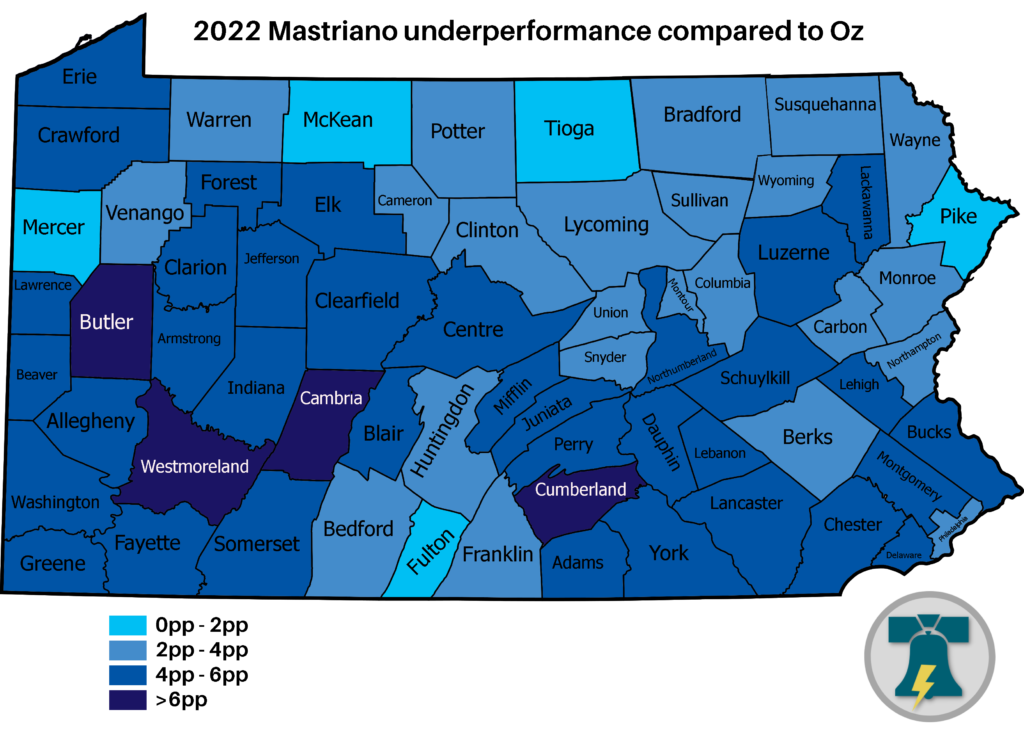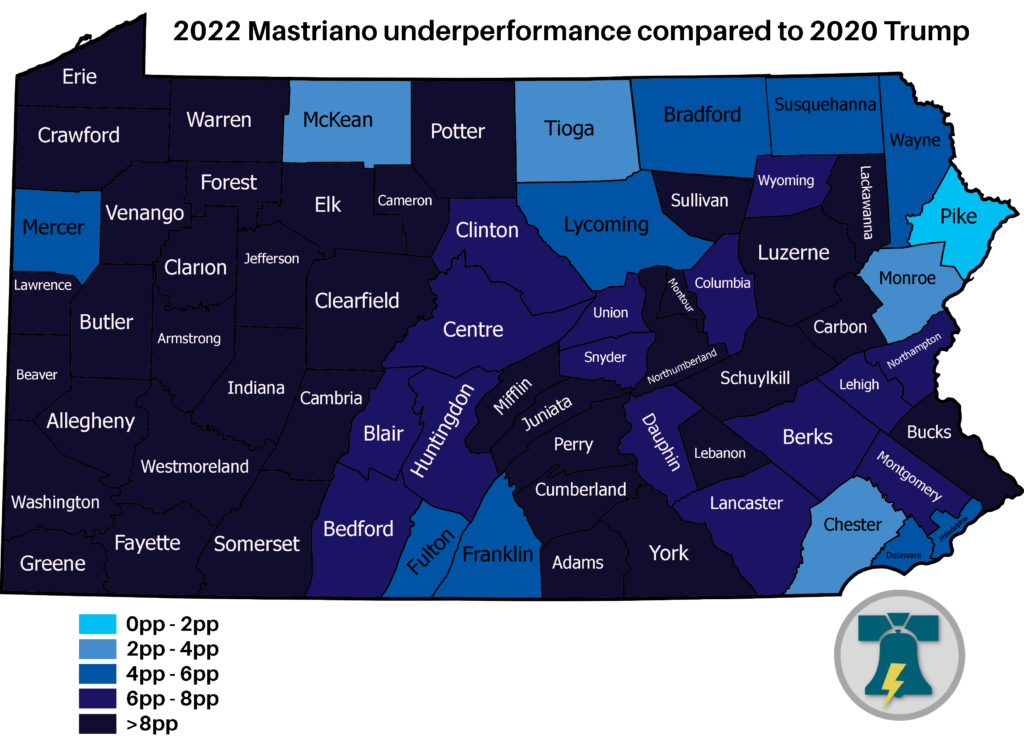Kyle Sammin: Some hard lessons for Pennsylvania Republicans after the midterms
Looking over the electoral maps for bright spots for conservatives after the midterm elections in Pennsylvania, and there is not much on which to concentrate. I set out to examine where Republicans fell short and the quick answer is: everywhere.
That said, comparing the performances of Doug Mastriano and Mehmet Oz with that of more successful candidates in previous elections, we can discern some useful information, and even some evidence that hints at where there is room to grow the Republican vote in 2024
The traditional way for Republicans to win in Pennsylvania is to do very well in the so-called “T” — the northern tier of the state plus the central part of the southern half — while doing decently well in the suburbs and hoping not to get killed in Philadelphia and Pittsburgh. In this, both of the Republican candidates obviously failed. But just how they did so is illuminating.
Mastriano ran well behind Oz in every county. That is not too surprising: polls, flawed as they were this time around, accurately predicted the gap between Oz’s popularity and Mastriano’s. But the spread was not uniform across the commonwealth, as the map below shows.

The spots where Mastriano was closest to Oz may represent the strongest Republican areas, places in which the average voter was most likely to vote the straight ticket, no matter how different the nominees on it were. These counties are part of the “T”, Pennsylvania’s Republican heartland. Mastriano won these counties, as did Oz, as nearly every Republican who has run there in recent years. But that he won them by less than Oz showed his weakness even among the GOP’s base.
Mastriano also trailed Donald Trump’s 2020 percentages in these areas. In fact, he took a significantly smaller share of the vote than Trump in all 67 counties.

This is a much deeper blue map. Statewide, Mastriano trailed Trump’s 2020 vote totals by more than a million votes, but that isn’t the fairest comparison — Josh Shapiro trailed Joe Biden’s vote totals, too. That’s common in a midterm compared to a presidential election year. But in terms of Mastriano’s share of the vote — the percentage of total votes cast —the fall-off was also considerable, a total of 6.7 percent statewide.
And remember: Trump lost Pennsylvania in 2020. Mastriano would have to have done seven percentage points better just to get close to winning.
Only in Pike County did Mastriano even approach Trump’s 2020 numbers. Pike was a consistently strong county for Republicans this year. I’m not completely sure why but we know Pike County has a small population that has recently shown a sharp increase. If this increase was disproportionately Republican — political exiles from New York and New Jersey, perhaps — it could account for the county’s increased conservatism.
A third map shows Mehmet Oz’s performance against Trump’s 2020 numbers, and this one also has a few interesting outlier counties.

One fact that jumps out at the reader is that there is a small segment of red! In one of the state’s 67 counties, Oz got a higher percentage of the vote than Trump: Chester.
It’s not obvious why this should be the case, but one Chester County politico I spoke with suggested that Oz’s frequent campaign visits may have helped (Fetterman only visited the county once). Another factor may have been that the 2020 Trump voters there were less blue-collar than in neighboring Delaware County, making them a better target for Oz’s less populist campaign style.
Oz likewise held Trump voters pretty well in the other suburban counties. Where he saw the steepest declines was in western Pennsylvania, where Trump won many conservatives to his cause in 2016 and held them in 2020. This seems to give proof to the conventional wisdom circulating before the election that Oz, despite running a thorough and active campaign, had failed to convince many conservative Republicans that he was the real deal.
Oz’s Hollywood associations and limited connection with the state made him a tough sell to MAGA Republicans, despite the early endorsement of the original MAGA Republican, Donald Trump. Finding a candidate who could win over those voters while also appearing moderate enough to win in the southeastern Pennsylvania suburbs was never going to be easy. As these numbers show, Oz was far more effective at the latter task than the former.
But despite Oz’s weakness in the west, if you remove Philadelphia from the equation, he would have won. Obviously that is not enough — Philly is part of the state — but it shows that Oz had considerable appeal in the other 66 counties.
Mastriano’s loss was more thoroughgoing. If you remove Philadelphia and the four suburban counties of Bucks, Chester, Delaware, and Shapriro’s home base of Montgomery, he would still have won the election by 30,000 votes. Shapiro won in places Republicans needed to carry, including Luzerne County and Beaver County. He lost Lancaster, a Republican stronghold, by less than two percent. Republicans will draw many lessons from this defeat, but one of them has to be that this is not the way to win Pennsylvania.
There is more to the story, of course, than focusing on the losing vote totals. Fetterman’s “every county, every vote” slogan suggested that he would campaign in areas traditionally hostile to Democrats. Did he win there? No. But he reduced Oz’s share of the vote, something Oz was unable to do to Fetterman in Philadelphia.
Likewise, Shapiro’s outreach to moderates and even conservatives gave people a feeling that they could safely vote for him over Mastriano. A more doctrinaire progressive who only wanted to rally the Democrat base would not have won those non-Democrat votes. Some would have voted for Mastriano despite reservations, and others would have gone third party or skipped the vote altogether. But the disparity in the third-party vote — 1.80 percent in the governor’s race versus 2.42 percent in the senate contest — suggests that more voters felt that there was at least one palatable major-party option there.
Kyle Sammin is Broad + Liberty’s editor-at-large.





I believe that the governor’s race affected the the senate race. Mastriano turned off so many Philadelphia voters that Oz had too much of an uphill battle there. Had there been a less stridently Trumpist candidate for governor, Oz would possibly have had a better chance. I am surprised that Oz didn’t do better in Bucks county given Fitzpatrick’s win there.
Hand written ballots, with carbon copies for voters. All counting completed on Election Day. End use of computerized voting immediately.
Be careful if you (Republicans) think Shapiro is really behind topics such a school choice and energy independence, etc. Topics that are of utmost importance to conservatives. Only time will tell if the “flip flopping” on the agenda that the Dems do so well will turn out to be another lie only to win an election. If it happens that way, then the only ones to blame are the ones who complain the most about the outcome of this election and, just as important, are the ones who didn’t even bother to come out and vote. Again. Do not continue to let the government to rule our lives. Remember, “It’s we the people”.
Ranked choice may work in primaries, but not general election. Alaska in 2022 and Georgia in 2020 show the fallacies of some of these alternative systems.